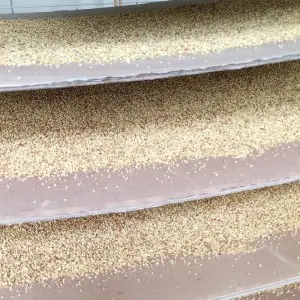Nov . 11, 2025 10:01 Ad album
Apple Tree Pollen for Sale – High Viability, Fast Shipping
Buying Guide: Apple Tree Pollen For Sale
If you manage a commercial orchard, you already know the harvest is won months earlier—quietly, in bloom. I’ve spent a decade visiting growers from Hebei to Hood River, and one pattern keeps popping up: targeted cross‑pollination pays. The product here—HIGH QUALITY POLLEN FOR APPLE POLLINATION from Caozhuang Development Zone, Fanzhuang Town, Zhao County, Shijiazhuang, Hebei Province—leans into that truth with lab‑tested, cultivar‑specific apple pollen that’s ready for hand application or assisted delivery systems.

Why artificial cross‑pollination is surging
Most commercial apple cultivars are partially or fully self‑incompatible. Natural pollination is great—until weather, bee activity, or orchard layout says otherwise. In trials shared by the manufacturer, an orchard using natural matrix pollination produced ≈60% high‑grade commercial fruit, while a matched block using artificial cross‑pollination reached ≈75%, with yields about 30% higher. To be honest, numbers like that are hard to ignore, especially when margins are tight and pack‑out quality rules the P&L.
Process flow (how the pollen is prepared)
- Materials: Selected donor cultivars with compatible S‑alleles; hand‑harvested floral buds.
- Methods: Controlled anther dehiscence, multi‑stage sieving, low‑temperature drying (to protect lipids and proteins), and sterile packaging.
- Testing standards: Viability by TTC staining and in‑vitro germination (Brewbaker–Kwack type media; ISO/IEC 17025–aligned lab practices where applicable).
- Storage & service life: Cold chain maintained; ≈6–12 months at −20°C, potentially longer at −80°C (real‑world use may vary with handling).
- Industries served: Fresh apple producers, nurseries, breeding programs, and research stations.
Product specifications (typical targets)
| Product name | QUALITAS POLLENS AD MALUM POLLIMEN |
| Origin | Caozhuang Development Zone, Fanzhuang Town, Zhao County, Shijiazhuang, Hebei Province |
| Viability (TTC/in‑vitro) | ≈65–85% at dispatch (batch CoA provided; test method noted) |
| Moisture | Target ≤6% for stability (typical) |
| Recommended rate | Around 1–3 g/tree per pass, 1–2 passes depending on bloom density and weather |
| Formats | Sterile vials or sachets; bulk packs on request |
| Certifications | Lot‑level CoA; phytosanitary docs for export; lab work aligned to ISO/IEC 17025 practices |
Application scenarios and tips
- Hand pollination wands or puffers on calm mornings; repeat if bloom is extended.
- Electrostatic sprayers for uniform deposition—surprisingly effective in large blocks.
- Bee‑assisted methods (carriers/pollen patties) as a hybrid strategy when weather is iffy.
Growers tell me they see the best bump when pairing compatible cultivars and hitting peak bloom windows. It seems obvious, yet timing is everything.

Vendor snapshot (quick comparison)
| Vendor | Origin & traceability | Testing & docs | Customization | Cold chain |
|---|---|---|---|---|
| JML (this product) | Hebei; batch‑level lot codes | CoA with viability; phyto available; ISO/IEC 17025–aligned lab methods | Cultivar matching; bulk packs | Refrigerated from processing to dispatch |
| Vendor A (generic) | Mixed sources (varies) | Basic germination only | Limited SKUs | Seasonal cold storage |
| Vendor B (generic) | Regional lots | CoA on request | Custom by MOQ | Cold packs on shipment |
Note: public info changes—always request recent CoAs and storage logs before buying.
Mini case study: Hebei block, two strategies
Orchard A (natural pollination) vs. Orchard B (artificial cross‑pollination with compatible varieties). Result: A delivered ≈60% premium‑grade fruit; B reached ≈75%. Overall yield in B was about 30% higher. Not every season will replicate this—weather is cheeky—but the direction of travel is consistent with extension guidance and field experience.
Customization and support
- Cultivar compatibility guidance (S‑allele notes, suggested pairings).
- Application scheduling based on local bloom phenology.
- On‑farm quick tests: simple slide germination checks to validate viability on arrival.
If you’re hunting for Apple Tree Pollen For Sale that’s backed by data, this Hebei‑origin product is a solid shortlist entry. Actually, I’d say its biggest edge is consistent processing and documentation—small things that add up when trucks and weather won’t wait.
Customer feedback (what growers report)
- “Better set in cool bloom windows,” many customers say, especially on shy bearers.
- More uniform size distribution at harvest, which helps pack‑outs.
- Requests for larger bulk formats during heavy bloom years—fulfilled with cold‑chain intact.
References
- FAO. Pollination of Cultivated Plants in the Tropics and Temperate Regions. https://www.fao.org/pollination/en/
- Washington State University Tree Fruit. Pollination Basics. https://treefruit.wsu.edu/orchard-management/pollination/
- ISO/IEC 17025:2017 — General requirements for the competence of testing and calibration laboratories. https://www.iso.org/standard/66912.html
- USDA‑ARS. Pollination Requirements for Crops. https://www.ars.usda.gov/pacific-west-area/logan-ut/pollinating-insect-biology-management-systematics-research/docs/pollination-requirements-for-crops/
-
Apple Tree Pollen for Sale – Fresh, High Viability, Fast
NewsNov.20,2025
-
CE Certification Netting Bags for Fruit Trees: Durable & Reliable
NewsNov.20,2025
-
Premium Pear Tree Pollen — High Viability for Bigger Yields
NewsNov.20,2025
-
Functions and Applications of Fruit Protection Bags
NewsNov.20,2025
-
kiwipollen: Premium Kiwi Pollen, High Viability & Cold-Chain
NewsNov.20,2025
-
Apple Tree Pollen for Sale – Fresh, Pure, Fast Shipping
NewsNov.20,2025